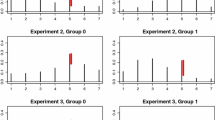Abstract
The concept of an ordinal instrumental probabilistic comparison is introduced. It relies on an ordinal scale given a priori and on the concept of stochastic dominance. It is used to define a weakly independently ordered system, or isotonic ordinal probabilistic (ISOP) model, which allows the construction of separate “sample-free” ordinal scales on a set of “subjects” and a set of “items”. The ISOP-model is a common nonparametric theoretical structure for unidimensional models for quantitative, ordinal and dichotomous variables.
Fundamental theorems on dichotomous and polytomous weakly independently ordered systems are derived. It is shown that the raw score system has the same formal properties as the latent system, and therefore the latter can be tested at the observed empirical level.
Similar content being viewed by others
References
Andersen, E. B. (1973).Conditional inference and models for measuring. Copenhagen: Mentalhygiejnisk Forlag.
Birnbaum, A. (1968). Some latent trait models and their use in inferring an examinee's ability. In F. M. Lord & M. R. Novick (Eds.),Statistical theories of mental test scores (pp. 397–545). Reading: Addison-Wesley.
Cliff, N., & Donoghue, J. R. (1992). Ordinal test fidelity estimated by an item sampling model.Psychometrika, 57, 217–236.
Fischer, G. H. (1974).Einführung in die Theorie psychologischer Tests [Introduction into the theory of psychological tests]. Bern: Huber.
Fischer, G. H. (1987). Applying the principles of specific objectivity and of generalizability to the measurement of change.Psychometrika, 52, 565–587.
Fishburn, P. C. (1973). Binary choice probabilities: On the varieties of stochastic transitivity.Journal of Mathematical Psychology, 10, 327–352.
Holland, P. W., & Rosenbaum, P. R. (1986). Conditional association and unidimensionality in monotone latent variable models.The Annals of Statistics, 14, 1523–1543.
Irtel, H. (1987). On specific objectivity as a concept in measurement. In E. E. Roskam & R. Suck (Eds.),Progress in mathematical psychology-1, (pp. 35–45). Amsterdam North-Holland: Elsevier.
Irtel, H. (1993). The uniqueness structure of simple latent trait models. In G. H. Fischer & D. Laming (Eds.),Contributions to Mathematical Psychology, Psychometrics, and Methodology (pp. 265–275). New York: Springer-Verlag.
Irtel, H., & Schmalhofer, F. (1982). Psychodiadnostik auf Ordinalskalenniveau: Meßtheoretische Grundlagen, Modelltest und Parameterschätzung [Psychodiagnostics on ordinal scale level: Measurement theoretic foundations, model test and parameter estimation].Archiv für Psychologie, 134, 197–218.
Junker, B. W. (1990).Progress in characterizing strictly unidimensional IRT representations. Pittsburgh: Carnegie Mellon University.
Krantz, D. H., Luce, R. D., Suppes, P., & Tversky, A. (1971).Foundations of measurement, Vol. 1. New York: Academic Press.
Meredith, W. (1965). Some results based on a general stochastic model for mental tests.Psychometrika, 30, 419–440.
Mokken, R. J. (1971).A theory and procedure of scale analysis. Paris/Den Haag: Mouton.
Mokken, R. J., & Lewis, C. (1982). A nonparametric approach to the analysis of dichotomous item responses.Applied Psychological Measurement, 6, 417–430.
Rasch, G. (1960).Probabilistic models for some intelligence and attainment tests. Copenhagen: Danish Institute for Educational Research.
Rasch, G. (1977). On specific objectivity: An attempt at formalizing the request for generality and validity of scientific statements. In M. Blegvad (Ed.),The Danish yearbook of philosophy (Vol. 14, pp. 58–94). Copenhagen: Munksgaard.
Robertson, T., Wright, F. T., & Dykstra, R. L. (1988).Order restricted statistical inference. New York: John Wiley.
Rosenbaum, P. R. (1988). Item bundles.Psychometrika, 53, 349–359.
Scheiblechner, H. (1972). Personality and system influences on behavior in social contexts: Frequency models.Acta Psychologica, 36, 322–336.
Scheiblechner, H. (1979). Specifically objective stochastic latency mechanisms.Journal of Mathematical Psychology, 19, 18–38.
Scheiblechner, H. (1994). Estimation and testing procedures for isotonic probabilistic models (ISOP). In preparation.
Stout, W. F. (1987). A nonparametric approach for assessing latent trait unidimensionality.Psychometrika, 52, 589–617.
Stout, W. F. (1990). A new item response theory modeling approach with applications to unidimensionality assessment and ability estimation.Psychometrica, 55, 293–325.
Suppes, P., & Zinnes, J. (1963). Basic measurement theory. In R. D. Luce, R. R. Bush, & E. Galanter (Eds.),Handbook of mathematical psychology, Vol. 1. New York: Wiley.
Author information
Authors and Affiliations
Additional information
I wish to thank 3 reviewers and 2 editors who contributed a lot to the readability and precision of the article.
Rights and permissions
About this article
Cite this article
Scheiblechner, H. Isotonic ordinal probabilistic models (ISOP). Psychometrika 60, 281–304 (1995). https://doi.org/10.1007/BF02301417
Received:
Revised:
Issue Date:
DOI: https://doi.org/10.1007/BF02301417




